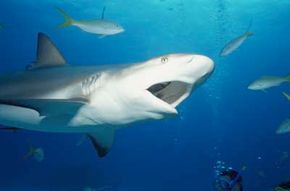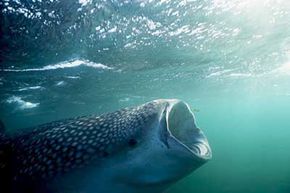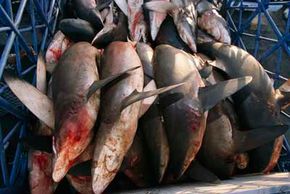
With close to 400 shark species floating around, you could fill volumes cataloguing their individual food habits. While cookiecutter sharks take nonlethal bites of flesh from their prey and call it a day, great white sharks may eat large sea mammals in one big gulp. And certainly the dietary customs of the 8-inch (20-centimeter) dogfish shark vary from that of the 60-foot (20-meter) whale shark, not to mention the different cousins, aunts and uncles in between.
Shark Image Gallery
Advertisem*nt
All sharks are at least partly carnivorous. They usually consume between 0.5 and 3.0 percent of their body weight each meal since most space their dinners out to every two or three days. Although their bodies are well equipped for catching food, they can't chew well, so they need time to properly digest [source: Cawardine].
Since sharks stand at the top of the aquatic food chain, their diets play an important role in regulating the species below them, much like lions in the jungle. For instance, if large sharks were to die out, that would increase the population of octopus, which in turn would feed on more lobsters [source: New York Times].
In addition, shark hunting habits help to perpetuate a survival of the fittest mode in their environment. To conserve energy, sharks often target weak, immature or sickly fish or mammals [source: Parker]. That weeds out the more vulnerable creatures and keeps the stronger, healthier fish and animals alive.
What fish and mammals in particular are sharks dining on? Find out on the next page.
Advertisem*nt
Contents
- Shark Diet Variations
- Sharks as Food
Shark Diet Variations

Setting the interfamilial variations aside for a moment, the average shark dines on fish, squid and crustaceans [source: Parker]. When it comes to more specific diet preference, here are some favorites of individual shark species:
- Hammerheads dine on stingrays.
- Smooth dogfish sharks like to eat crabs and lobsters.
- Tiger sharks eat sea turtles.
- Blue sharks prefer squid.
[source: SeaWorld]
Advertisem*nt
Interestingly, the largest shark species, the whale shark, does not hunt at all. Enormous whale sharks, megamouth sharks and basking shark filter feed on plankton. These species have specialized gills that sift through water to extract the microscopic algae and sea creatures that comprise plankton. Just by indiscriminately taking water into their mouths, basking sharks filter 528,000 gallons of water each hour, extracting 4.5 pounds (2 kg) of food [source: Parker].
Some larger, faster sharks extend their diet to include sea mammals, in addition to substantial fish such as tuna, mackerel and other sharks. Great white sharks, tiger sharks and mako sharks may also consume seals, sea lions, sea birds, dolphins and porpoises.
Tiger sharks are probably the least discriminating in their culinary tastes. Stomach contents from tiger sharks have included license plates, turtles, sea snakes and gasoline canisters [source: Discovery Channel].
If you aren't sure what type of food a certain shark species eats, check out its mouth. Different sharks have specialized teeth tailored to their preferred prey. Great whites have razor-sharp, triangular fangs to slice through the thicker, fattier flesh of larger fish and sea mammals. Since tiger sharks enjoy crustaceans, their teeth resemble steak knives with serrated edges and a rounded shape to break through the shells. Filter feeders like whale sharks have row upon row of short, blunt teeth since they don't have to rip through anything [source: Parker].
But despite sharks' reputation for voracious appetites, they may be the target of something else's mealtime cravings. Find out on the next page when sharks become prey.
Advertisem*nt
Sharks as Food

In the food hierarchy of the sea, large sharks often swim at the top. However, even the fierce great white sharks have enemies in the water. Killer whales that weigh around 5 tons (4,535 kilograms) have eaten great whites before [source: Cawardine]. Crocodiles, seals and other sharks may also prey on younger sharks.
By far, sharks' most threatening predator is humans. Shark meat has become increasingly popular as food, and manufacturers also use shark cartilage in some medicines. In 2007, the United States exported 4,160 tons of shark and dogfish meat [source: National Marine Fisheries Service]. Although the United States imported 32 tons of shark fin in 2007, it, along with Canada, New Zealand, Australia and South Africa, has banned the fishing tactic of catching sharks, slicing off their fins and tossing them back in the water [source: National Marine Fisheries Service].
Advertisem*nt
Because of the success of commercial shark fishing and the problems with catching sharks as a byproduct of other fishing ventures, certain species populations have dwindled recently. Some shark experts have estimated that the overall number of sharks in the water has dropped as much as 90 percent [source: Kelly]. They also fear the decline because sharks reproduce at a much slower rate than other fish because most species carry their pups like mammals. At the same time, commercial shark fishing advocates argue that the business profits fishermen and also protects people from deadly shark attacks.
In reality, the widespread concern about shark attacks is overblown in relation to the incidence rate. People die each year from gruesome shark-related injuries, but only 30 of the nearly 400 species have ever made contact with humans [source: Florida Museum of Natural History]. Of those 30 or so species, shark specialists consider around a dozen as potentially harmful to people. Because of the higher concentration of muscle in humans' bodies, sharks will sometimes take a bite and release a victim since they prefer fattier foods [source: Klimely].
For more information on sharks and other sea life, read the links on the next page.
Advertisem*nt
Shark Diet FAQ
What do sharks like to eat the most?
Sharks are carnivores. They are predators who eat invertebrates and large sea mammals including seals and dolphins. Some species prey on seals, mollusks, mackerel, tuna, squid, stingrays and crustaceans.
Why is shark meat not eaten?
Shark meat is consumed in certain parts of the world, though not in North America. However, it’s not commonly eaten due to high levels of mercury, and more than that, many species are classified as endangered.
Can you hunt sharks in the U.S.?
Hunting sharks is prohibited in the U.S. as per the Shark Conservation Act. Slicing their fins off while they are alive and dumping them back in is also illegal.
Would a shark eat a human?
Even though sharks are predators, they rarely attack humans and almost never eat them. They may attack for self-defense or when they are curious or confused, but they really only eat marine mammals and fish.
Lots More Information
Related Articles
- How Sharks Work
- How Great White Sharks Work
- How Bull Sharks Work
- How Tiger Sharks Work
- How Nurse Sharks Work
- How Shark Attacks Work
- How do sharks smell, hear and see?
- 15 Tips for Surviving a Shark Attack
- Why do people collect shark teeth?
- Could shark cartilage help cure cancer?
More Great Links
Sources
- Carwadine, Mark. "Shark." Firefly Books. 2004. (May 14, 2008)http://books.google.com/books?id=Qh44RNa5yh0C
- International Shark Attack File. "The Relative Risk of Shark Attacks to Humans." Florida Museum of Natural History. Updated June 2007. (May 27, 2008)http://www.flmnh.ufl.edu/fish/Sharks/attacks/relarisk.htm
- Lloyd, Robin. "Sharks Decline But Attacks Rise." LiveScience. Feb. 27, 2008. (May 15, 2008)http://www.livescience.com/animals/080227-aaas-sharks.html
- Kelly, Erin. "For Sharks, Real People are Predators." Gannett News Service. Aug. 4, 2003.
- Klimley, A. Peter. "The Predatory Behavior of the White Shark." American Scientist. March/April 1994.
- National Marine Fisheries Service. "Imports and Exports of Fisheries Product Annual Summary, 2007." US Department of Commerce. (May 15, 2008)http://www.st.nmfs.noaa.gov/st1/trade/documents/TRADE2007.pdf
- National Oceanic and Atmospheric Administration. "Our Fear of and Fascination with Sharks." NOAA Magazine. June 3, 2002.
- New York Times. "Great White Shark: Fierce But Necessary." Aug. 8, 1986.
- Parker, Jane and Parker, Steve. "The Encyclopedia of Sharks." Firefly Books. 2002.
- SeaWorld. "Sharks Background Information. August 2001. (May 15, 2008)http://www.seaworld.org/just-for-teachers/lsa/i-012/pdf/background.pdf